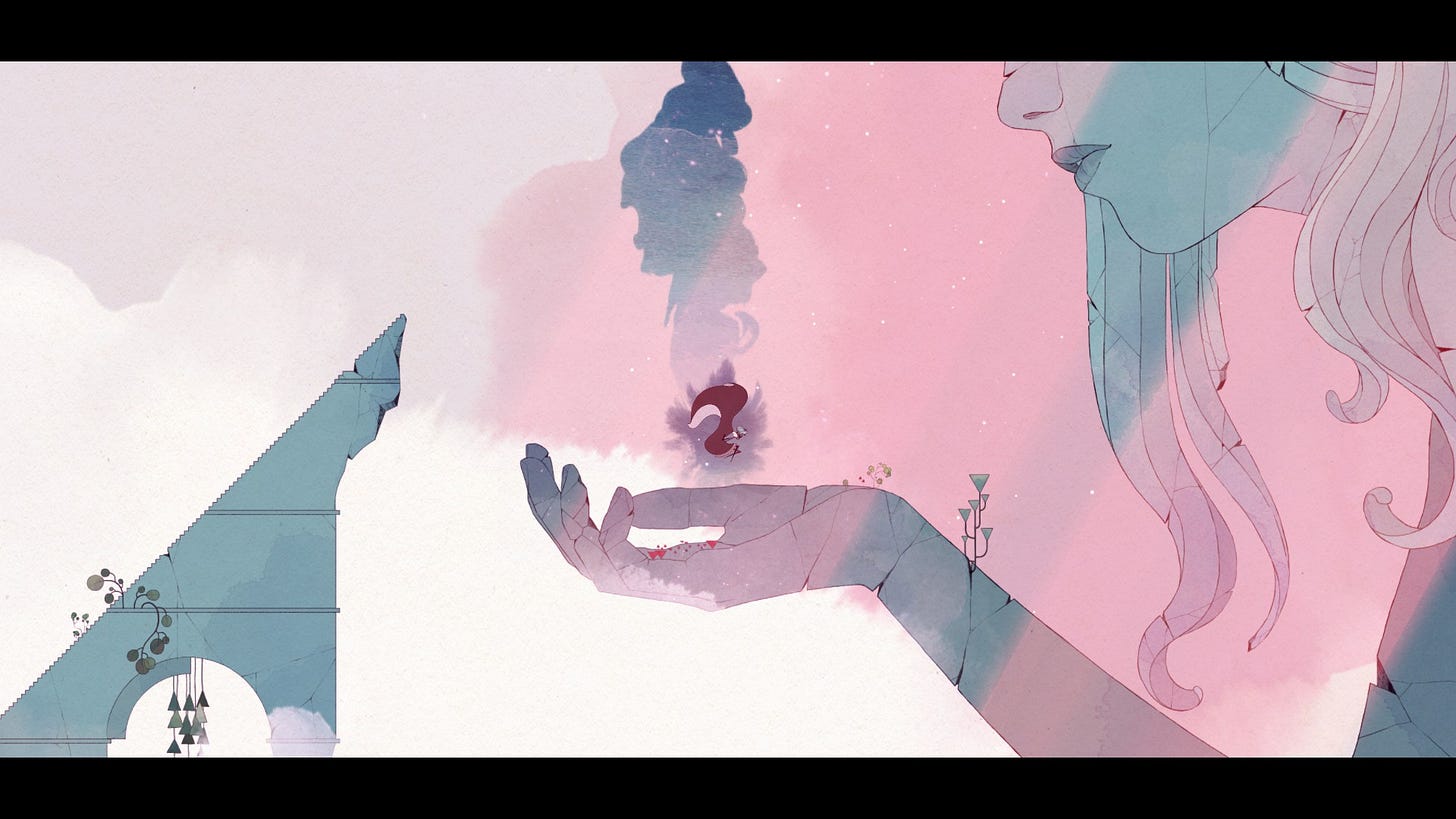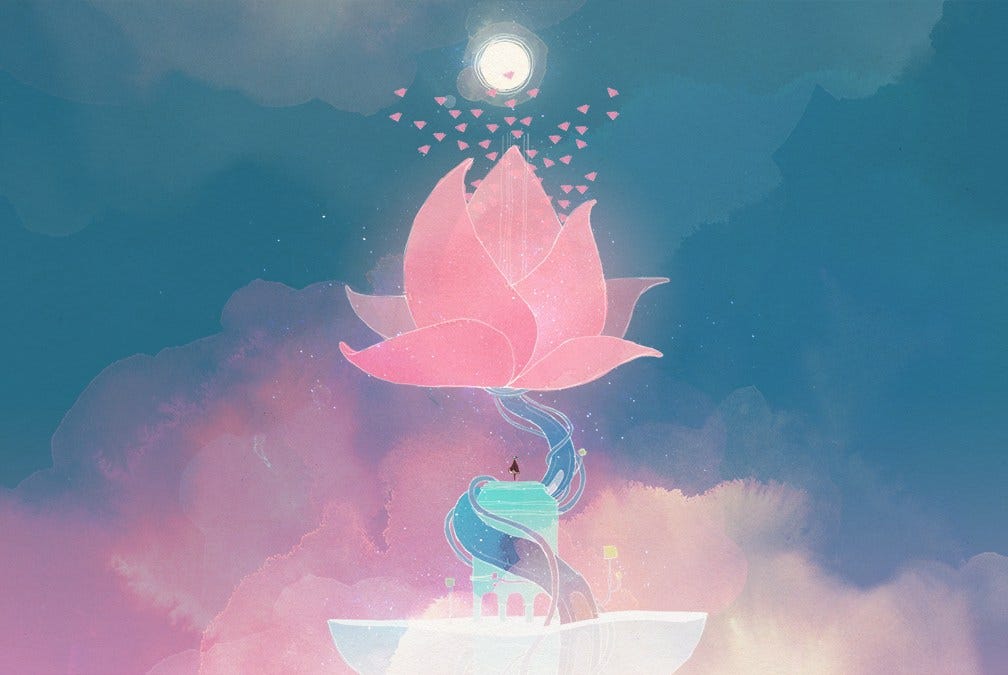How The Game 'GRIS' Transforms Grief Into Gameplay
Exploring the emotional architecture behind Nomada Studio’s hauntingly beautiful platformer.
I had the pleasure of stumbling onto a gem of a game—GRIS. What I expected to be a brief distraction turned out to be one of the most moving gaming experiences I’ve had in a while.
But, what is…GRIS?
The name GRIS means “grey” in Spanish, a nod to both the game’s opening palette and the liminal emotional space its heroine inhabits. As you explore, new colours slowly return to the world, each tied to a stage of healing.
The game is short—around three to four hours—but its blend of elegant mechanics, stunning art direction, and evocative music has made it one of the most acclaimed indie titles of the past decade.
What it’s like to play GRIS
A side-scrolling platformer with no dialogue, combat, or fail states, it’s deceptively simple on the surface. But beneath that surface lies a profound comment on grief, loss, and transformation - delivered through movement, colour and sound.
It doesn’t ask much of you mechanically, but it asks everything emotionally. Each step, each jump, each quiet moment is steeped in metaphor, encouraging you to reflect not only on what the character is going through, but what you may be carrying yourself.
In this article, I’ll explore how GRIS handles grief, not just as a narrative device, but as a lived process. I’ll look at the game’s elegantly minimalist mechanics and how they guide without instruction, challenge without punishment, and gently reveal growth through gameplay. Finally, I’ll celebrate the breathtaking art direction that brings this world to life—through colour, animation, and composition that speaks louder than words ever could.
This is more than a game….it’s a visual poem. A requiem for what was, and a quiet, hopeful hymn for what might still be.
Grief as a Playable Emotion
GRIS doesn’t rely on exposition to explain what its protagonist is going through. Instead, it externalises her emotional journey through visual metaphor and gameplay design—transforming inner turmoil into shifting landscapes, dissolving architecture, and moments of suspended movement. Grief is not once referenced; but you can feel it echoing through the core of the visuals.
The game loosely follows the five stages of grief, though not in a rigid, textbook way. Each chapter introduces a new hue—red, green, blue, yellow, and finally, full colour—paired with corresponding emotional states: anger, fear, sorrow, hope, acceptance.
The red chapter, with its howling winds and unstable footing, feels aggressive and disorienting. The blue chapter pulls you underwater, into a slow, dreamlike space where everything is muffled and heavy. The green chapter introduces gravity-defying trees and whimsical traversal—a lightness that arrives like a long exhale after sadness.
What’s striking is how GRIS allows you to rebuild not by fixing the world, but by learning how to move through it differently. The ruins remain. But your relationship to them changes. As you gain new abilities—turning to stone to anchor yourself, singing to awaken dormant life—you aren’t becoming stronger in the traditional sense. You’re learning how to live alongside pain. How to carry it with more grace.
At the centre of it all is the recurring statue of the woman—shattered, eroded, almost mythic. As you collect fragments and slowly reconstruct her form, you begin to understand: she’s not just a mother figure, or a memory. She’s the part of yourself that grief has taken. And piece by piece, you reclaim her.
Simple Mechanics, Intricate Design
At first glance, GRIS feels almost too simple. There are no enemies. No death. No traditional puzzles in the usual sense. You move, you jump, and occasionally interact with the world around you. But beneath that softness is a tightly crafted structure—one that creates the feeling of being lost, while quietly guiding you every step of the way.
The game offers no map, no UI, no on-screen instructions. You’re given space to wander, to drift, to explore without pressure. Yet somehow, you rarely lose your way. The level design is fluid and intuitive, using light, movement, architecture, and music to gently pull you forward. A shaft of sunlight might draw your eye to a crumbling ledge. A fluttering flock of birds might signal the path ahead. These cues are never intrusive. They simply exist—placed with care, waiting for you to notice.
Each new ability unfolds seamlessly into the world. Turning to stone to resist howling winds. Gliding through the air. Swimming through vast, silent waters. Singing to restore life. These moments are paced with intention, tied not just to progression but to emotional shifts. It never feels like you’re unlocking power for its own sake.
What’s striking is how gently the game treats you. You can’t fail. You won’t die. The challenge comes not from overcoming obstacles, but from understanding how to navigate them with new awareness. It reflects a deeper truth: grief doesn’t require mastery. It asks for patience, resilience, and the courage to keep going—even when you don’t fully understand where you’re headed.
The Elegance of Art Direction
From the very first frame, GRIS announces itself as something crafted with extraordinary care. Its world is hand-painted, almost translucent—built from delicate lines, fluid animation, and a colour palette that feels as emotionally alive as the protagonist herself. There’s a sense of precision in every brushstroke, but it never feels clinical.
The environments themselves feel like illustrations caught in motion—ethereal but grounded. Crumbling temples, swirling storms, endless staircases rising toward the sky. Some areas feel almost sacred, others quietly desolate. Every location carries a specific emotional weight, often enhanced by the way it sounds as much as how it looks. Sometimes the space is wide and open, other times narrow and confining, as if the world itself is breathing with you—expanding and contracting with your state of mind.
Silence plays a vital role too. There are long stretches where nothing happens, visually or sonically—and that stillness hits just as hard as the game’s sweeping musical crescendos. The score, composed by Berlinist, is haunting and minimal, rising and falling with your journey. It feels less like background music and more like memory made audible—shimmering at the edges, never quite resolving.
In GRIS, art direction isn’t just about beauty. It’s emotional architecture. Every colour, every shape, every sound exists in service of what the character—and the player—might be feeling in that moment.
A Game That Understands
GRIS doesn’t shout.
What makes it so powerful is how much trust it places in the player. Trust that you’ll notice the way a shadow moves, or the way colour returns to the sky. Trust that you’ll connect with a character who never speaks, because her silence feels familiar.
By the time you reach the final moments, there’s no grand twist, no triumph waiting at the end. What you find instead is a sense of release. A calm.
GRIS lingers long after the credits, and you realise that healing doesn’t erase pain—it just transforms it into something new.
This is a game that doesn’t just explore grief. It gives you a way through it.







